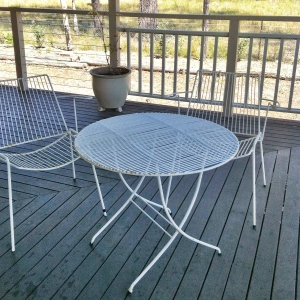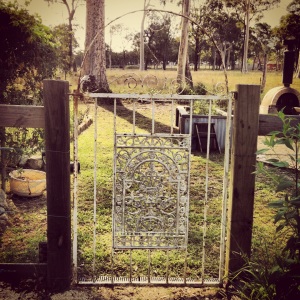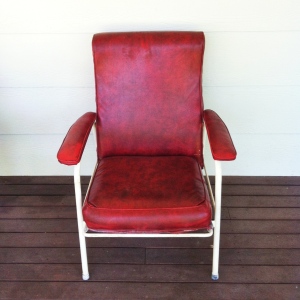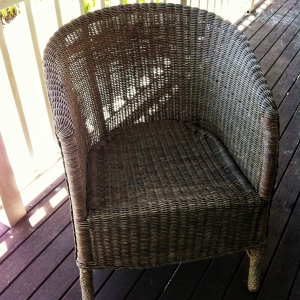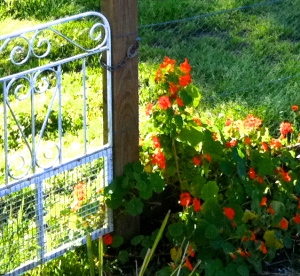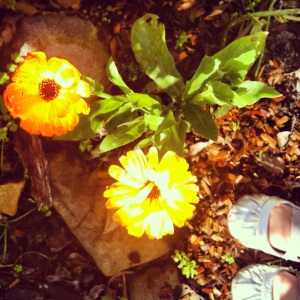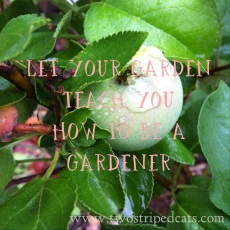My gosh I didn’t expect to have another prolonged break from my blog. But now that the craziness (but nevertheless awesomeness) of Christmas is out of the way, the Event of the Year (my big sister’s wedding) has occurred and was absolutely breathtaking and beautiful, and some other stuff has been ticked off my long list, I can get on with things in the blog department.
Aside from these other activities, I’ve been spending quite a bit of time in my old garden again. It’s one of my favourite places to be. And it’s also my thinking spot. Though the thinking doesn’t happen very coherently with a toddler and preschooler constantly butting in. Nevertheless when I was out in the garden the other day I thought: ‘I really, really need to write a blog post.’ And at the same time I was feeling some plant love. Which gave me an idea for this post: a spiel about my favourite plants in my garden. I don’t mean my favourite plants in general. I’m talking about plants that are useful and easy to grow or to propagate, in a permaculture-type garden (and in my temperate, almost subtropical climate in Australia). Some are edible and some are not. And others might be classified as ‘edible’, but I wouldn’t eat them unless I was starving on a desert island and they happened to be growing there.
Firstly I’d like to point out that I only have formal qualifications in animals, not plants. So don’t take my word for it. But I have been a gardener for a long time and I have spent many hours reading gardening books and magazines and watching gardening shows on telly (I think Kosta and Peter are pretty special – my apologies if you live outside Australia and haven’t the vaguest clue who Kosta and Peter are but trust me, they’re gardening heroes in my neck of the woods).
Here’s my list:
Queensland Arrowroot (Canna edulis)
Arrowroot is an attractive plant with large, green leaves and occasional (but beautiful) scarlet flowers. The leaves are used for animal fodder and mulch. The plant produces a large tuber, which can be cooked and eaten in similar ways to potatoes (roasted is my favourite) and also made in to flour. (Although I’ve heard the rewards are disproportionate to the effort with regard to the latter.) It is the tuber which is planted and divided for propagating (too easy). Like all good Queenslanders, arrowroot is remarkably tough and likes a warm climate. I recently had a bucket full of tubers sitting out in the hot weather for a couple of months yet they were still producing new shoots. I planted them two weeks ago in the most horrible, compacted, dry (due to lack of watering) clay soil and the plants have already shot up to 20-30cm above the ground. So although they apparently like fertile soil and ample water (even waterlogged areas) they survive with sheer neglect. Despite this I haven’t found them to be weedy perhaps because their spread is slow and the plants can easily be removed by way of the large tubers. Actually, when planted en masse and in a row, arrowroot can act as a weed barrier and will also protect other plants from wind and sun.

Comfrey (Symphytum Officinale)
Comfrey is one of those plants that gets me excited. If you were to judge it on outward appearances you might think it was a nasty, prickly weed. But it is wonderful and produces the most nutritious organic matter for the garden, by way of mulch, compost or liquid fertiliser (just add water and a few weeks). Comfrey can be eaten in moderation, and is particularly beneficial for chooks. I’m yet to sample the infamous comfrey fritter, though. There seem to be two schools of thought on its gastronomic merits: one that says it tastes just lovely, with a slight fishy flavour (which does nothing whatsoever to tempt me) and another that says don’t even bother! Comfrey is another robust plant and after being cut back, the leaves will regrow in a matter of weeks depending on the time of year (about 4 weeks to reach maximum size in the current warmth of summer at my place). If planted close together it can be used as a weed barrier, for example, along the edge of a garden bed. Once it is planted in a particular location comfrey can be tricky to remove, as the plant will regrow from any little pieces of root that remain in the soil. So plant it in a spot where it’s welcome to stay for a long while.

Lemongrass (Cymbopogon species)
Another excellent mulching plant which is also hardy. It grows to around 1m high and forms a large clump. The plant is easily propagated by dividing up the clump or digging out smaller sections of roots from the main plant then replanting those. Because of the strong clump that is formed, lemongrass can be a useful edging or barrier plant, to stop weeds getting past or to act as an informal border to a garden bed. It is happy with average soil and little water. And I don’t think I need to inform you of its fabulous culinary reputation!

Tamarillo (Cyphomandra betacea)
Tamarillo is a small, fast-growing tree that produces a bounty of delicious fruit of the same name. I usually describe these as being a cross between a tomato and passionfruit. Tamarillo trees begin fruiting within two or three years of planting, but only live for around five to seven years. So it’s generally recommended to plant more trees every three years. They can be grown from seed (very easy to collect) or cuttings. They are a must-have fruit tree for a warm climate.
Blueberries (Vaccinium species)
We planted nine blueberry bushes along the front of our house when we first moved here and now I consider that a wise investment. They started fruiting for us in their second year, and since then we have picked bucketfuls of berries each spring. The bushes grow quickly and are relatively resistant to pests and diseases but they do need reasonable watering and regular additions of organic matter to produce yummy berries. Mine conveniently live adjacent to the comfrey row, so every now and then I simply pull off gloved handfuls of comfrey leaves and pile them around the base of each bush. And since they like acidic soil, they get treated to our coffee grounds, too. A plant that likes coffee has got to be super cool, don’t you think!? But one of my favourite things about growing my own blueberries (or any berries for that matter) is that it saves me from buying them in little plastic containers. And I can eat handfuls of them at a time without feeling guilty about over-spending! Of course birds like to eat beakfuls of them at a time. So you might want to cover them with a wildlife-friendly netting, such as Vege Net, which I purchased from Green Harvest. It ensured we actually had some blueberries left for ourselves this year.


Salvias (Salvia species)
Of all the flowering perennials I have a soft-spot for the salvias. I grow several varieties around my garden and they never fail to give me a warm, fuzzy, plant-loving feeling. Salvias are drought tolerant and grow quite fast and easily from cuttings. I have been known to just stick a salvia cutting into the ground rather than bothering with a pot; that’s how readily they produce roots. So if you haven’t propagated plants via cuttings before, salvias are an excellent starting point. Salvias are useful for attracting beneficial insects such as bees and for just looking pretty. Many are also culinary herbs – common sage (Salvia officinalis) is probably the most widely known. My favourite though is pineapple sage (Salvia elegans) because it does actually smell and taste of pineapples (perfect for adding to cool summer drinks) and produces a gorgeous scarlet flower for much of the year.




Here is a list of some other plants that I reckon are fabulous to grow in an organic or permaculture-style garden:
- Gourd (Lagenaria siceraria) – grows from seed, on a vigorous, annual vine; the fruit can be eaten when small but I like to let them grow into giants that become unique ornaments and vessels when dried.
- Luffa (Luffa aegyptiaca) – grows easily from seed on an annual vine. And yes you can make your own luffa scrubbers with the fruit! One plant will provide you with enough luffas for a few years, depending on how much you utilise them. Not only are they fabulous exfoliators, they also make useful compostable cleaning scrubbers eg,for washing the dishes.
- Nasturtium (Tropaeolum majus) – self seeds readily but not too far from the parent plant because the seeds are quite large. A pretty ground cover with a long flowering period. The flowers are a lovely addition to salads and the green seeds can be pickled and eaten as a caper substitute.

- Aloe (Aloe vera)- I keep this handy in a pot on the verandah, ready to break open a leaf and apply the magic soothing gel as required to insect bites and minor burns. It actually appreciates being sheltered from the sun in summer so being near the front door suits us both. Being a succulent it tolerates minimal watering.

- Globe artichoke (Cynara scolymus)- a survivor and easily propagated by dividing plants. And of course absolutely delicious!

- Rosella – heat-tolerant and easily grown from seed. Makes the best jam you will ever try!

- Scented geranium (Pelargonium species) – scented geraniums are easily propagated from cuttings, hardy and drought-tolerant with pleasant fragrances that vary amongst the species.

- Coneflower (Echinacea species) – coneflowers are survivors and their flowers are just divine. Excellent bee-magnets!
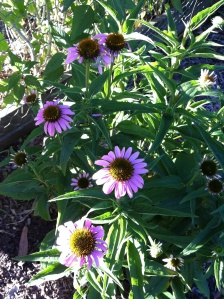
If you live in Australia, I realise now is not the ideal planting time by any means. Many parts of the country have been getting sizzled by the heat for the past week and I’m sure there’s more of that to come. And I’d imagine if you reside in the northern hemisphere now might not be a wonderful time to plonk innocent seeds or vulnerable cuttings into the soil either. Nevertheless I hope I’ve given you some ideas for planting in the upcoming milder seasons. Bring on Autumn and Spring!



